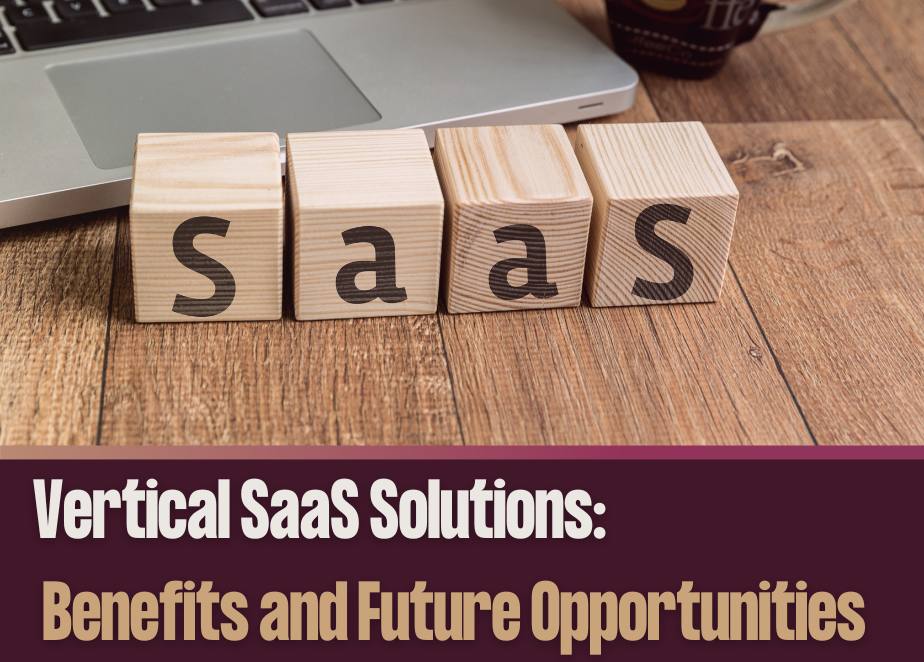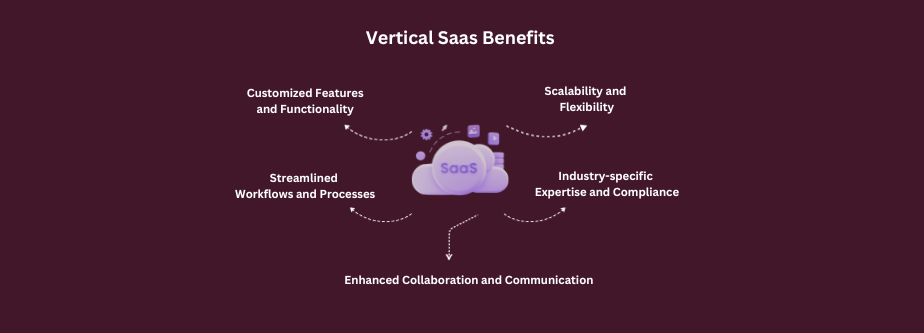Vertical SaaS Solutions: Benefits and Future Opportunities

What is Vertical SaaS?
Over the past decade, industry-specific software, commonly referred to as Vertical SaaS, has gained significant popularity among investors.
Welcome to the world of Vertical SaaS Solutions, where industry-focused innovation is changing the game. Vertical SaaS is an increasingly essential factor in driving business success. So what is Vertical SaaS? Put simply, it refers to industry-specific software-as-a-service solutions that help organizations unlock the full potential of their operations. This revolutionary approach to software delivery goes beyond the one-size-fits-all solutions of the past, delivering customized functionalities that streamline workflows and help businesses differentiate themselves in their respective markets. With the growing popularity of Vertical SaaS solutions across various industries, it’s clear that this approach is here to stay. In this article, we’ll explore the definition, importance, and impact of Vertical SaaS in today’s business landscape.
Understanding Vertical SaaS
Let’s dive a little deeper. To understand Vertical SaaS, we first need to understand the concept of Software as a Service (SaaS). As you may know, SaaS refers to a software delivery model where a provider delivers applications over the internet, with users accessing the software through their web browser. The benefits of SaaS are numerous and well-documented, including lower costs, improved accessibility, and better security, among others.
However, not all SaaS solutions are created equal. This is where the distinction between Vertical SaaS and Horizontal SaaS becomes important. Horizontal SaaS solutions are general, broad-based software tools that can be used across different industries. These solutions offer many advantages, but they are not tailored to the specific workflows and needs of particular industries. In contrast, Vertical SaaS solutions are customized, industry-specific tools that deliver targeted functionality and data to help businesses operate more efficiently and effectively. By implementing Vertical SaaS solutions, businesses can gain a strategic edge over their competitors, reducing costs and increasing revenue. In short, Vertical SaaS is the future of software delivery, offering tremendous advantages for businesses in specific industries.
Benefits of Vertical SaaS Solutions

So what is the reason behind this phenomenal growth? VSaaS companies frequently prioritize the development of solutions for intricate or underserved industries that larger software companies have generally disregarded.
Consider small businesses in industries such as healthcare, food service, financial services, or construction. These businesses often face difficulties in keeping up with the constantly changing regulations, distinct business models, and complex sales processes. Thankfully, they now have a lifeline in the form of vertical software solutions tailored to meet their unique needs. These solutions have truly made their lives a whole lot easier, simplifying their operations and allowing them to thrive in their respective industries.
Vertical SaaS solutions offer a multitude of advantages for businesses operating in specific industries. Some of these key benefits:
- Customized Features and Functionality
- Streamlined Workflows and Processes
- Industry-specific Expertise and Compliance
- Enhanced Collaboration and Communication
- Scalability and Flexibility
Industries and Applications of Vertical SaaS
Vertical SaaS solutions are finding applications in various industries, transforming the way businesses operate and revolutionizing industry-specific processes. Here are some prominent industries that are benefiting from Vertical SaaS solutions.
- Legal Sector
Vertical SaaS solutions are now being applied in the legal industry, offering features such as case management, document automation, billing, and legal research. These solutions help law firms and legal professionals streamline their processes, improve collaboration, and enhance overall efficiency. - Retail and E-commerce
VSaaS solutions empower retailers to manage customer data, streamline inventory, process online payments, and offer personalized shopping experiences to customers. - Real Estate and Property Management
Vertical SaaS solutions cater to the needs of real estate professionals by simplifying lease management, and property maintenance, and facilitating communication with clients and stakeholders. - Finance and Banking
Vertical SaaS solutions streamline financial operations, enhance compliance and risk management, and provide efficient accounting and record-keeping solutions for banks, financial institutions, and other organizations. - Healthcare and Medical Services
Vertical SaaS solutions in healthcare provide advanced features for efficient patient management, secure data sharing, and streamlined billing and insurance processes.
These industries are just a glimpse of the wide range of applications that Vertical SaaS solutions offer. With industry-specific features and functionalities, businesses across various sectors can benefit from the scalability, customization, and efficiency that Vertical SaaS solutions bring to the table.
Challenges and Considerations in Adopting VSaaS Solutions
When considering the adoption of vertical SaaS solutions, businesses may encounter various challenges and considerations. Firstly, integration with existing systems can be a hurdle, as seamless compatibility between the new solution and the current infrastructure is essential for smooth operations. Secondly, data security and privacy concerns arise, as businesses must ensure that their sensitive information is adequately protected within the SaaS environment. Thirdly, cost considerations and return on investment play a crucial role, as businesses need to assess the financial implications and potential benefits of implementing the solution. Lastly, selecting the right vendor and ensuring ongoing support is critical for successful adoption, as businesses rely on the vendor’s expertise and assistance throughout the implementation and usage of the vertical SaaS solution. Overall, understanding and addressing these challenges and considerations are essential for the integration of vertical SaaS solutions into business operations.
Success Stories of Vertical SaaS Adoption
The success stories of vertical SaaS adoption are plentiful and span across various industries. Case studies and examples showcase how businesses in healthcare, retail, manufacturing, and other sectors have reaped the rewards of implementing vertical SaaS solutions.
- Vermeer Corporation.
A manufacturer of agricultural and industrial equipment, Vermeer Corporation faced challenges with manual tracking of parts inventory. By implementing a vertical SaaS solution from Plex Systems, Vermeer improved inventory management, reduced errors, and achieved real-time visibility into parts usage and availability. - Hyatt Hotels Corporation.
A global hospitality company, Hyatt Hotels Corporation adopted a vertical SaaS solution from Duetto Research, to enhance revenue management and optimization. With the SaaS solution, Hyatt experienced an increase in revenue, improved employee productivity, and greater insights into customer behaviour. - Quorum Health Corporation.
A healthcare services provider, Quorum Health Corporation struggled with an inefficient method of managing hospital pharmacy inventory. By utilizing a vertical SaaS solution from PartsSource, Quorum improved inventory management, increased ordering accuracy, and saved $2 million in procurement costs within the first year of implementation.
These success stories highlight the positive outcomes and measurable benefits that businesses have experienced. Increased operational efficiency, streamlined processes, enhanced collaboration, and improved customer satisfaction are just a few of the advantages that businesses have enjoyed as a result of adopting vertical SaaS solutions. These real-world examples serve as inspiration and motivation for other businesses considering the integration of vertical SaaS solutions into their own operations.
Future Trends and Opportunities in Vertical SaaS
Vertical SaaS shows immense potential for the future, with the predicted growth and availability of emerging technologies, such as cloud computing, IoT, and blockchain. By incorporating these technologies and emphasizing the integration of AI and ML, Vertical SaaS solutions can enhance data analytics, offer personalized experiences, and automate repetitive tasks, thereby enabling businesses to be more operationally efficient while providing better customer experiences. Companies that adopt these latest technologies and trends have the potential to stay ahead of the competition, unlock new possibilities, and ultimately, achieve greater success in their respective industries.
Among the future trends in VSaas,
- Predicted growth and expansion.
The future of vertical SaaS appears bright, with predicted growth and expansion in various industries. As businesses increasingly recognize the benefits of tailored solutions, the demand for vertical SaaS is expected to rise. This growth is fuelled by the need for industry-specific functionalities and the desire for streamlined operations and enhanced customer experiences. Vertical SaaS providers are likely to see increased demand from businesses looking to leverage these solutions to stay competitive and meet evolving industry requirements. - Emerging technologies and innovations:
The development of emerging technologies presents new opportunities for vertical SaaS solutions. Advancements in cloud computing, Internet of Things (IoT), and blockchain technology have the potential to revolutionize vertical SaaS offerings. These technologies can enhance data connectivity, provide real-time insights, enable secure transactions, and improve overall system capabilities. Vertical SaaS providers that innovate and incorporate these technologies into their solutions have the potential to gain a competitive edge and attract more customers. - Impact of Artificial Intelligence and Machine Learning:
Artificial Intelligence (AI) and Machine Learning (ML) are poised to have a significant impact on the future of vertical SaaS solutions. With AI and ML capabilities, vertical SaaS solutions can automate repetitive tasks, analyze complex data sets for valuable insights, and deliver personalized experiences to users. This technology can enable predictive analytics, enhanced recommendation engines, and intelligent automation, empowering businesses to make data-driven decisions and optimize their operations. Vertical SaaS providers that embrace and incorporate AI and ML into their solutions can offer advanced functionality and drive greater value for their customers.
Summary
To recap on the advantages and benefits of Vertical SaaS, let’s list the advantages and benefits for businesses they bring:
- Tailored solutions.
Vertical SaaS provides industry-specific functionalities and features, catering to the unique needs of various sectors. - Improved efficiency.
By streamlining processes and automating tasks, Vertical SaaS helps businesses operate more efficiently, reducing manual efforts and minimizing errors. - Enhanced collaboration.
Vertical SaaS solutions facilitate seamless collaboration and communication among different teams and departments, fostering better coordination and productivity. - Real-time insights.
With data and analytics capabilities, Vertical SaaS enables businesses to gain valuable insights and make informed decisions based on real-time information. - Cost savings.
Vertical SaaS eliminates the need for extensive hardware infrastructure and upfront investment, allowing businesses to save on IT costs and scale more easily.
As businesses increasingly recognize the value and benefits of industry-specific solutions, the demand for Vertical SaaS is expected to grow significantly. The integration of emerging technologies, such as AI, ML, IoT, and blockchain, offers exciting possibilities for the evolution of Vertical SaaS, enabling businesses to further optimize their operations, drive innovation, and stay competitive in their respective industries.
Vertical SaaS’s impact on industries will continue to be profound. It empowers businesses to adapt and thrive in rapidly changing markets, providing them with the tools and capabilities needed to meet industry requirements, deliver exceptional customer experiences, and drive sustainable growth. More businesses embrace Vertical SaaS, so we can expect to witness transformative changes across various sectors, leading to increased efficiency, productivity, and overall success.
By leveraging its tailored solutions, embracing emerging technologies, and capitalizing on future possibilities, businesses can unlock greater efficiencies, improve customer experiences, and position themselves for long-term success in their respective industries, Vertical SaaS holds immense potential and offers numerous advantages for businesses.
Strathsquare is a seed stage project initiator that provides required resources to entrepreneurs and innovators. We are driven by a sense of urgency to transition away from unsustainable technologies and processes, we believe that what we do should have a genuinely positive impact on society and our environment.
If you have an innovative idea
We are committed to supporting innovators who have the potential to make businesses more sustainable and for all.


